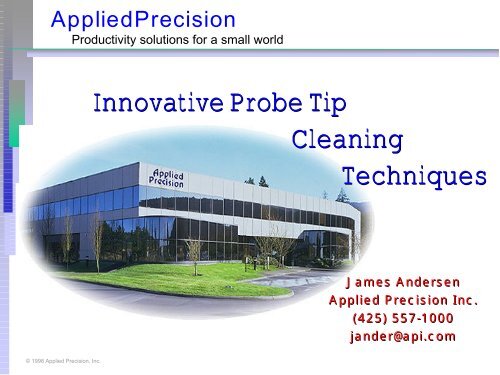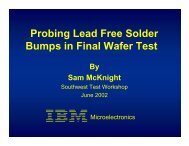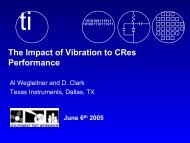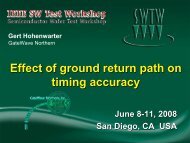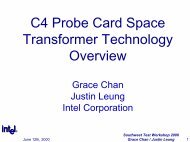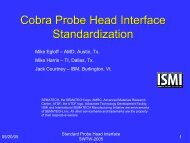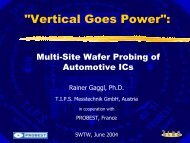Innovative Probe Needle Cleaning Techniques
Innovative Probe Needle Cleaning Techniques
Innovative Probe Needle Cleaning Techniques
Create successful ePaper yourself
Turn your PDF publications into a flip-book with our unique Google optimized e-Paper software.
AppliedPrecision<br />
Productivity solutions for a small world<br />
<strong>Innovative</strong> <strong>Probe</strong> Tip<br />
<strong>Cleaning</strong><br />
<strong>Techniques</strong><br />
James Andersen<br />
Applied Precision Inc.<br />
(425) 557-1000<br />
jander@api.com<br />
© 1998 Applied Precision, Inc.
Industry Survey<br />
• What are the suspected contaminants?<br />
• What is thought to cause high Contact<br />
Resistance?<br />
– Aluminum Oxide<br />
– Anti-reflectives<br />
– Tungsten Oxide<br />
– Passivation<br />
– Silicon Nitride<br />
– Tri-nitrides<br />
– Polymers & Fluorocarbons (due to over etch)<br />
– Lapping media (adhesive)<br />
– Electrically activated buildup of dielectrics<br />
– Outgassing of packing materials<br />
© 1998 Applied Precision, Inc.
Industry Survey<br />
• Compounds containing these elements<br />
were identified using SEM & Auger<br />
Analysis<br />
– Oxygen<br />
– Sulfur<br />
– Chlorine<br />
– Carbon<br />
– Nitrogen<br />
– Copper<br />
– Aluminum<br />
– Silicon<br />
© 1998 Applied Precision, Inc.
Industry Survey<br />
• How do you determine when a<br />
card is “dirty”?<br />
– It exhibits high contact resistance<br />
– Yield fallout assumed to be a result of high Cres<br />
– Reprobe failure rate doesn’t improve - assumed to be<br />
a result of high Cres<br />
– By visual inspection<br />
© 1998 Applied Precision, Inc.
Industry Survey<br />
• What methods do you use to<br />
“clean”?<br />
– Scrub on Tungsten Carbide<br />
– Scrub on Lapping films<br />
– Scrub on SandPaper<br />
– Camel Hair dry brushing - to remove particulates<br />
– IPA wet brushing<br />
– Scrub on Ceramic<br />
– Dish Soap followed by DI water<br />
• What do you think reduces Cres??<br />
– Abrasion, physically removing the “contaminants”<br />
© 1998 Applied Precision, Inc.
Scrubbing on Tungsten Carbide<br />
Effectively reduces contact resistance<br />
20.00<br />
18.00<br />
16.00<br />
14.00<br />
12.00<br />
1000 TD's<br />
W SCRUB<br />
OHMS<br />
10.00<br />
8.00<br />
6.00<br />
4.00<br />
2.00<br />
0.00<br />
49<br />
51<br />
53<br />
42<br />
39<br />
40<br />
37<br />
38<br />
35<br />
PROBE<br />
36<br />
33<br />
34<br />
31<br />
32<br />
29<br />
30<br />
27<br />
20<br />
18<br />
16<br />
1000 TD's<br />
BUT...<br />
© 1998 Applied Precision, Inc.
Abrasive <strong>Cleaning</strong><br />
• Abrasive <strong>Cleaning</strong>...<br />
– Causes deformation of the tips<br />
– Reduces <strong>Probe</strong> Card Life<br />
– Produces additional contaminants<br />
– Is incompatible with some probe card technology<br />
A non-destructive<br />
cleaning alternative<br />
is needed!<br />
© 1998 Applied Precision, Inc.
Chemicals and Solvents<br />
• Sodium Hydroxide<br />
• Potassium Hydroxide<br />
Did not pursue evaluation of wet<br />
chemicals due to restricted usage<br />
in wafer fabrication environments<br />
• Solvents<br />
Process intensive usage and appear<br />
to have little or no effect on contact<br />
resistance.<br />
© 1998 Applied Precision, Inc.
Chemicals<br />
18.0000<br />
16.0000<br />
DEOXIT<br />
5 Minute Bath in 100% Solution<br />
Cres Before<br />
14.0000<br />
12.0000<br />
10.0000<br />
8.0000<br />
6.0000<br />
4.0000<br />
2.0000<br />
Cres After<br />
0.0000<br />
162<br />
163<br />
164<br />
54<br />
60<br />
53<br />
61<br />
52<br />
62<br />
51<br />
63<br />
50<br />
64<br />
49<br />
127<br />
48<br />
125<br />
43<br />
42<br />
41<br />
© 1998 Applied Precision, Inc.
Our Mission ...<br />
To meet the industry requirement we<br />
need to find a cleaning method that<br />
is<br />
Non-abrasive<br />
Non-destructive<br />
Non-chemical<br />
Material Independent<br />
© 1998 Applied Precision, Inc.<br />
and EFFECTIVELY Reduces Contact<br />
Resistance
Acoustic Pressure Waves<br />
© 1998 Applied Precision, Inc.<br />
TIPS IN AN ACOUSTIC FOUNTAIN
Acoustic Energy<br />
High<br />
Frequency<br />
Acoustics<br />
produce a<br />
spatially<br />
defined energy<br />
field<br />
PRESSURE FIELD AS A STANDING WAVE<br />
© 1998 Applied Precision, Inc.
MegaSonic Acoustics<br />
BEFORE CLEANING<br />
AFTER CLEANING<br />
© 1998 Applied Precision, Inc.<br />
Radiation Pressure Forces and Localized<br />
Microstreaming Effectively Remove<br />
Particulates<br />
However...
MegaSonic Acoustics<br />
…Contact Resistance Increases!<br />
10.000<br />
9.000<br />
8.000<br />
AFTER<br />
7.000<br />
OHMS<br />
6.000<br />
5.000<br />
4.000<br />
3.000<br />
2.000<br />
BEFORE<br />
1.000<br />
0.000<br />
47 46 45 44 43 42 41 40 39 38 37 36 35 34 33 32 31 23 29 28 27 22 25 24<br />
S1<br />
© 1998 Applied Precision, Inc.<br />
PROBE
Carbon Dioxide “Snow”<br />
• Removes particles and organic<br />
contamination<br />
– High velocity gas<br />
– Momentum Transfer<br />
– Sublimation<br />
18.00<br />
Provides Excellent<br />
Particle Removal<br />
but Minimal<br />
Contact Resistance<br />
Improvement<br />
ohms<br />
16.00<br />
14.00<br />
12.00<br />
10.00<br />
8.00<br />
6.00<br />
4.00<br />
2.00<br />
Test 1<br />
Test 2<br />
0.00<br />
49<br />
51<br />
53<br />
42<br />
39<br />
40<br />
37<br />
38<br />
35<br />
36<br />
channel<br />
33<br />
34<br />
31<br />
32<br />
29<br />
30<br />
27<br />
20<br />
18<br />
16<br />
Test 1<br />
© 1998 Applied Precision, Inc.
What Causes Contact Resistance?<br />
This Card Has Never Touched a Wafer !<br />
16.00<br />
14.00<br />
12.00<br />
10.00<br />
OHMS<br />
8.00<br />
6.00<br />
4.00<br />
2.00<br />
0.00<br />
49 52 51 54 53 64 42 63 39 66 40 65 37 68 38 67 35 70 36 69 33 2 34 1 31 4 32 3 29 6 30 5 27 8 20 17 18 15 16<br />
CRes<br />
PROBE<br />
© 1998 Applied Precision, Inc.
<strong>Probe</strong> Card Storage<br />
OHMS<br />
1.40<br />
1.20<br />
1.00<br />
0.80<br />
0.60<br />
Test 1<br />
Test 2<br />
Nitrogen<br />
Purging/Vacuum<br />
Sealing Controls<br />
Contact Resistance<br />
0.40<br />
4.50<br />
0.20<br />
0.00<br />
43<br />
42<br />
41<br />
125<br />
48<br />
127<br />
49<br />
64<br />
50<br />
63<br />
51<br />
62<br />
52<br />
PROBE<br />
Vacuum Sealed<br />
61<br />
53<br />
60<br />
54<br />
162<br />
163<br />
164<br />
Test 1<br />
OHMS<br />
4.00<br />
3.50<br />
3.00<br />
2.50<br />
2.00<br />
Test 1<br />
Test 2<br />
1.50<br />
Test Performed at<br />
one week intervals<br />
1.00<br />
0.50<br />
0.00<br />
43<br />
42<br />
41<br />
125<br />
48<br />
127<br />
49<br />
64<br />
50<br />
63<br />
Stored in Air<br />
51<br />
62<br />
52<br />
PROBE<br />
61<br />
53<br />
60<br />
54<br />
162<br />
163<br />
164<br />
Test 1<br />
© 1998 Applied Precision, Inc.
What Causes Contact Resistance?<br />
Presence of Oxygen<br />
Suggests Existence of<br />
an Oxide Layer<br />
© 1998 Applied Precision, Inc.
MicroCluster Beam Technology<br />
© 1998 Applied Precision, Inc.
MicroCluster Beam Technology<br />
© 1998 Applied Precision, Inc.
MicroCluster Beam Technology<br />
© 1998 Applied Precision, Inc.
Rocket Science Reduces Resistance<br />
25.00<br />
20.00<br />
Test 2 Test 1<br />
15.00<br />
OHMS<br />
10.00<br />
5.00<br />
0.00<br />
© 1998 Applied Precision, Inc.
MicroCluster Beam Technology<br />
BEFORE<br />
AFTER<br />
MicroCluster Beam <strong>Cleaning</strong> Results in NO<br />
Measurable Changes to <strong>Probe</strong> Alignment,<br />
Planarity, or Tip Profile<br />
© 1998 Applied Precision, Inc.
Summary<br />
– Abrasive Scrubbing works, but is destructive.<br />
– Chemicals can work, but are destructive and face<br />
restricted usage in Fab environments.<br />
– Solvents are messy and ineffective.<br />
– High Frequency Acoustic <strong>Cleaning</strong> removes particulates<br />
but increases contact resistance.<br />
– CO 2<br />
Snow removes particulates but did not reduce contact<br />
resistance.<br />
Is MicroCluster Beam Technology<br />
the Solution?<br />
© 1998 Applied Precision, Inc.
Conclusion<br />
MicroCluster Beam Technology Exceeds Our<br />
Mission Objectives<br />
– Non-abrasive Method<br />
– No Measurable <strong>Probe</strong> Wear or Damage<br />
– Non-chemical<br />
– Dry process - No Bakeout Required<br />
– Independent of probe material, pitch, topography, type.<br />
MicroCluster Beam Technology Effectively and<br />
Consistently Reduces Contact Resistance!<br />
© 1998 Applied Precision, Inc.


